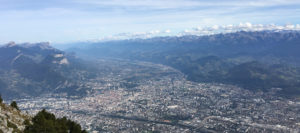Cold-air pooling in mountainous terrain – improving weather and climate prediction models with new observational data

Cold-air pools are stable atmospheric boundary layers confined towards the bottom of landscape depressions. Cold extremes and the accumulation of air pollution associated with cold-air pools can cause significant risks to agriculture (e.g., freezing temperature), transportation (e.g., fog and road icing) and human health (e.g., exposure to air pollution), across the UK and elsewhere.
The nature of cold-air pools depends on the scales of the orographic variations, the larger-scale flow and the land cover. While the effect of the large-scale flow is relatively well understood, that of the land-cover is not well characterised, particularly in urbanised (and forested) complex terrain. The interplay between valley and mountain winds with urban circulations has not received much attention. A couple of studies have indicated that an urban heat island circulation impedes the development of valley and mountain winds in the vicinity of the city, but the mechanisms involved remain poorly characterised, such that little is known about how it affects cold-air pooling.
The aim of the project is to advance understanding and modelling of the processes whereby urban areas affect cold-air pooling in mountainous terrain and their impacts on the environment.
The successful applicant will use numerical models (particularly the Met Office Unified Model with the urban-canopy model MORUSES) to examine how urban areas affect cold-air pooling in complex terrain (with a focus on Alpine valleys, some of which are highly urbanised). Idealised and realistic settings will be considered, and model results will be challenged against observations (from the TEAMx programme; see the next paragraph). This will involve evaluating cold-air pooling metrics as a function of urban parameters for a range of terrain scales and large-scale flow. The numerical experiments will consider perturbations of cold-air pool controls, particularly urban parameters.
The project is aligned with TEAMx (Multi-scale transport and exchange processes in the atmosphere over mountains – programme and experiment; http://teamx-programme.org), an ambitious international collaboration targeting the understanding of transport and exchange processes on all scales through modelling and intensive observation. There will be opportunities for travel to and fieldwork in the European Alps as part of the TEAMx programme.
The project is also aligned with the National Centre for Atmospheric Science (NCAS)’s science programme on climate and high impact weather. The student will be integrated within the NCAS research community.
The project is sponsored by the Met Office and the successful applicant will receive a Met Office CASE award, which provides additional stipend and research expense funding. The successful applicant will be expected to work with and visit the Met Office partner.
Applicants will possess a degree in mathematical, physical or environmental science. For further information, please contact Dr Charles Chemel (charles.chemel@ncas.ac.uk).
